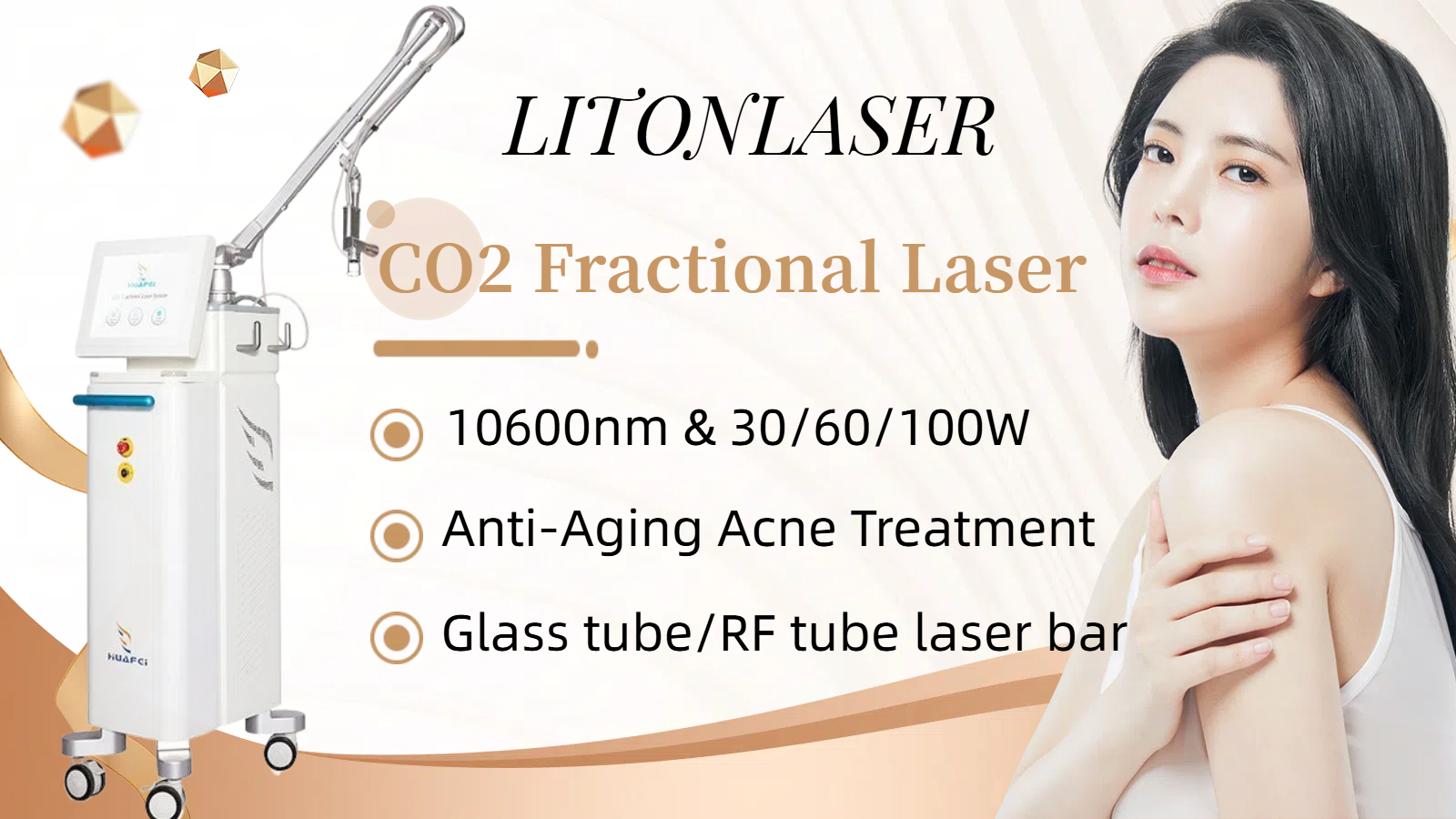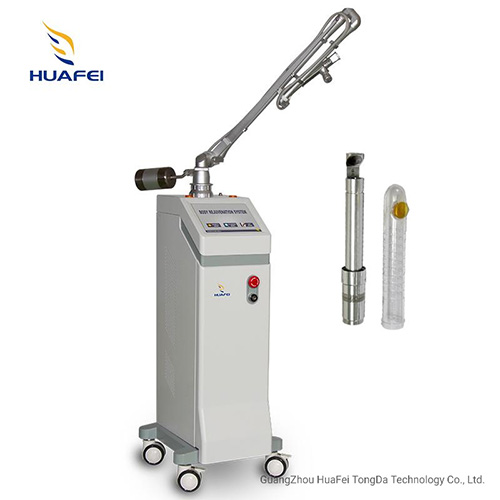1. What is fractional CO2 laser?
Fractional CO2 laser is a gas laser that uses C02 gas as a working medium to generate laser; fractional laser is the output mode of laser. After focusing the laser of a specific infrared wavelength, it forms small irradiation points with intervals through computer control and automated mechanical technology, and normal skin tissue is retained between each irradiation point.
The working principle of CO2 fractional laser is focal photothermolysis and stimulating regeneration effect. The wavelength is 10600nm, the target color base is water, and it belongs to the category of micro-Ablative and Ablative treatment. It has anti-aging and wrinkle removal, treatment of moderate to severe acne, large pores, auxiliary treatment of age spots, freckles, auxiliary treatment of depressed scars and hypertrophic scars, assisting treatment of alopecia areata, and enhancing product absorption.
2. What is acne?
Acne vulgaris is the most common chronic inflammatory skin disease that occurs in the hair follicles and sebaceous glands. It is caused by abnormal keratinocyte proliferation and desquamation, androgen-induced sebum production, and Propionibacterium acnes proliferation and inflammation, and immune response. It affects up to 90% of adolescents, although it occurs in different age groups.
3. Causes of acne.
3.1 Cause 1 of acne: Excessive keratinization of the hair follicle opening and abnormal keratinization of the hair follicle sebaceous gland duct.
In the skin of acne patients, the wax content is high and the linoleic acid content is low. The reduced linoleic acid content reduces the essential fatty acids around the hair follicles and promotes the keratinization of the hair follicle epithelium.
The keratinocytes in the lower part of the hair follicle funnel are not easy to fall off, resulting in thickening of the stratum corneum and accumulation of keratin, which blocks the hair follicle sebaceous gland duct, and sebum cannot be discharged normally, eventually forming keratin plugs, that is, micro-acne, which in turn causes acne.
3.2 Cause 2 of acne: endocrine factors.
A basic pathophysiological basis for the occurrence of acne is the rapid development of sebaceous glands and excessive sebum secretion. Androgen is an important endocrine factor that controls the development of sebaceous glands.
After entering puberty, regardless of gender, the level of androgen, especially testosterone, rises rapidly. In the skin, it is converted into dihydrotestosterone by 5-a reductase. It binds to the androgen receptors of sebaceous gland cells, promotes the development of sebaceous glands and produces a large amount of sebum.
3.3 Cause of acne three: microbial factors.
There are many microorganisms in hair follicles, such as Propionibacterium acnes, Staphylococcus albus and Malassezia. Note that Propionibacterium acnes also exists in healthy skin.
3.4 Cause of acne four: immune factors.
Not all people have acne under the above conditions. The immune system and genetic factors play a big role. Some aggregated, explosive acne, and acne caused by allergies after photoelectric surgery are all closely related to individual immune responses. Excessive immune response is actually an important factor in the occurrence of acne.
3.5 Cause of acne five: intestinal flora.
Acne is also closely related to the gastrointestinal tract. It is currently believed that the intestinal microbiota may be involved in the pathogenesis of acne, so it is related to antibiotics and diet. Perioral dermatitis and rosacea are also related to diet and gastrointestinal flora imbalance.
3.6 Cause of acne six: mental stress and emotions.
Mental stress and emotions (such as depression and anxiety) are hypothesized to aggravate acne by changing the intestinal microbiota and increasing intestinal permeability, and may cause acne.

4. Use fractional CO2 laser for acne treatment.
The wavelength of CO2 fractional laser is 10600nm, with a high water absorption coefficient of about 780, and has a strong epidermal exfoliation and superficial dermal destruction effect. After CO2 fractional laser treatment, tiny burn holes will appear on the epidermis, “coin-shaped” skin reactions will occur, the central tissue of the laser irradiation point will be completely vaporized and peeled off, the surrounding tissue will have a white frost reaction due to water vaporization, and the outermost tissue will have protein denaturation. The penetration and destruction depth of a single treatment is usually 80-150μm, causing columnar thermal damage/coagulation in the superficial dermis.
The working principle of CO2 fractional laser is “focal photothermal decomposition and stimulating regeneration effect”, which can kill Propionibacterium acnes. Whether it is open or closed acne, acne, acne can be treated with CO2 laser, and it can reduce existing acne pits, fade acne marks, control oil, and shrink pores.
The power is 15-20W, the pulse width is 2-4ms, and the point spacing can be appropriately denser at the location where redness, swelling or closure occurs, using 0.7-0.8mm. Whether it is closed comedones, blackheads, inflammatory outbreaks or other acne, fractional CO2 can be used for treatment. For mild nodular cystic acne, first use needle cleaning or use the CO2 laser head mode to drain, open the cyst wall, and clean the pus. For other parts of the face, the energy value refers to the parameters of skin rejuvenation, and it is recommended to cover the fractional coverage to avoid uneven skin color after surgery. After the treatment of the acne area, it can be treated once every 1-2 months, and the time for the next treatment can be determined according to age and skin repair status.
5. Choice of fractional CO2 laser.
Litonlaser is a professional beauty instrument manufacturer. It has a 20-year history of production and research and development of fractional CO2 lasers. It has a rich summary and clinical data collection on the application of machines, and has a deep research on the key indicators of machines. It can provide multi-level choices for the power, key parts, and appearance of CO2 lasers.
5.1 Fractional CO2 laser power of LITONLASER.
We provide three power fractional CO2 laser equipment of 30 watts, 60 watts, and 100 watts. Normally, 30W machines can be used for most beauty projects, such as anti-aging and wrinkle removal, acne removal, whitening and rejuvenation, etc. They are generally used in beauty salons and some clinics.
60W CO2 lasers are suitable for more professional clinics and hospitals. Higher power means that more difficult beauty skin problems can be solved, such as moderate to severe acne, acne pit treatment, dermal pigmentation removal, etc.
100W equipment requires very professional operators to use, and is generally not recommended for ordinary beauty salons unless professionally trained, because this power machine has very strong energy and is usually used for skin proliferative tissue cutting, which is biased towards the scope of surgical operations. Of course, Litonlaser will provide professional machine training courses.
5.2 Key part of CO2 fractional laser – laser bar.
There are two types of laser bars for CO2 fractional laser machines, namely glass tube laser bars and RF tube laser bars. Their performance is different, so the stability of the light output, the energy of the light source, and the service life are different. Generally, we recommend buying RF tubes, which will have better performance in all aspects and a higher price.
5.3 Various appearance models of 10600nm wavelength CO2 laser.
In order to adapt to the aesthetics of different countries, we customize multiple models of CO2 lasers, including 803, 807, 811, 509, etc. CO2 laser series: https://www.litonlaser.com/product_category/fractional-co2-laser/. Click to view detailed information.
If you are a beauty machine dealer or the owner of a beauty salon, and need to cooperate with a manufacturer with extremely cost-effective beauty equipment and rich clinical experience in machines, then you can contact us: https://www.litonlaser.com/contact-us/.











